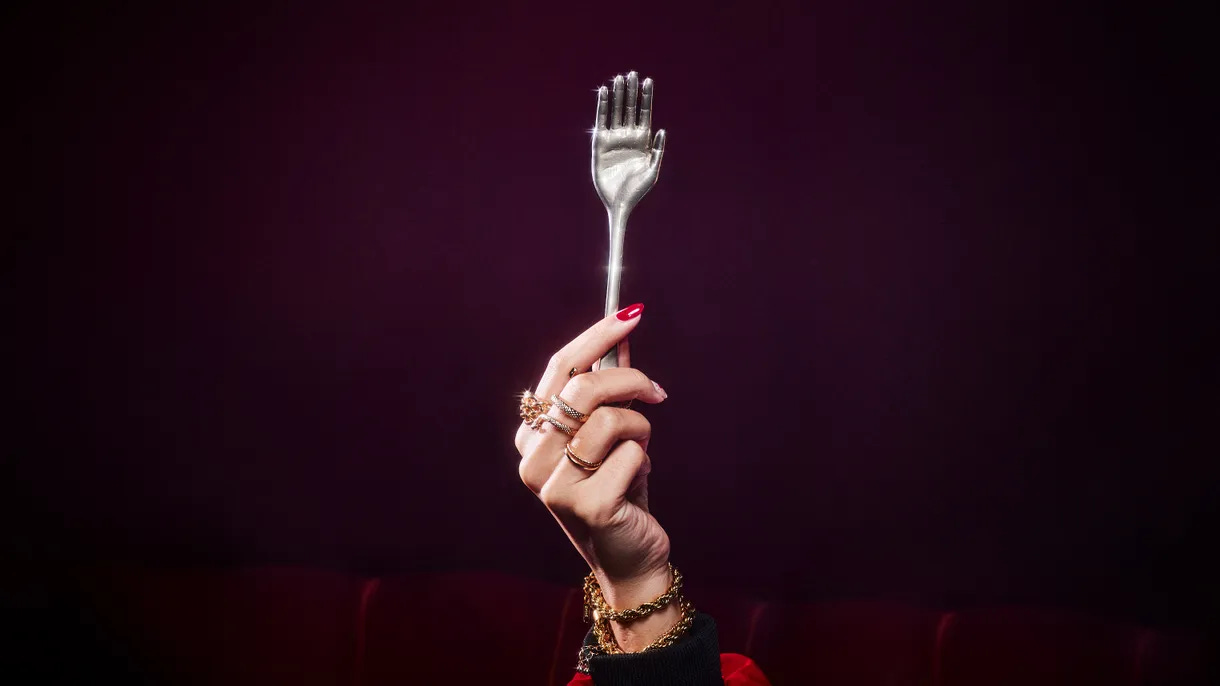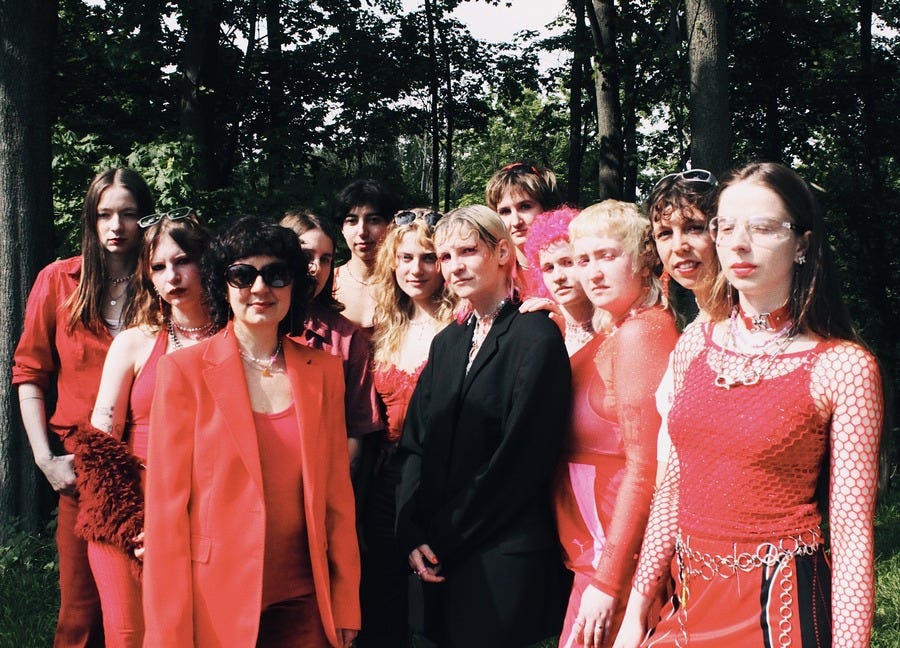🛸 The Orbit Dispatch: Issue #8
AI Mushrooms, Insect Aliens, and the Return of the McGriddle: Culture’s Weirdest Timeline Yet
Hello!
We’re back, slightly different, but with your monthly dose of the bizarre and delightful in creative culture, design oddities, and internet curiosities.
🌟 Fresh Orbit: Creative News & Quick Takes
In June, the World Economic Forum’s Annual Meeting in Tianjin spotlighted how art, tech, ai and ecology are colliding in wild new ways. The event featured several thought-provoking installations that pushed the boundaries of digital art:
Fungal Faculty by Thijs Biersteker used AI and mushroom-inspired networks to explore how tech quietly takes control.
Seeds of Tomorrow by Ronen Tanchum let people shape a living digital organism using movement, with AI reacting in real-time.
These installations tapped into a growing shift: artists using AI not to replace creativity, but to reimagine it.
More on AI: The integration of AI into the art world continued to accelerate, and generate debate. On July 8, the AI for Good Global Summit opened in Geneva, showcasing how AI can be directed toward sustainable development goals, with exhibits featuring everything from flying cars to AI-driven disaster response tools. Also, global AI rules are coming (eventually). The UN just launched a brand-new advisory group to make sense of the chaos. Will it work? Who knows. But at least they’re trying.
Pop Culture & Campaigns: Summer Kick-Offs and Celebrity Power: June kicked off the summer season with a flurry of brand activity and major cultural events. In the world of celebrity collaborations, Dunkin' partnered with singer Sabrina Carpenter for a retro-themed campaign for its Strawberry Daydream Refresher, while Pinterest launched its first-ever co-branded product, a Sea Salt Toffee coffee blend with influencer Emma Chamberlain.
July was dominated by major entertainment releases and nostalgic cultural moments. The film world saw the premiere of Jurassic World Rebirth on July 2, sparking a wave of dinosaur-themed memes and fan debates. The one-year anniversary of "Barbenheimer" on July 21 brought back the popular pink-and-black duality meme format.
McDonald's Makes McGriddles Permanent: To celebrate the McGriddles becoming a permanent breakfast menu item nationwide, McDonald's, through its agency Wieden+Kennedy Sydney, rolled out a new campaign on July 10.
Adobe dropped a new logo this year and… no one noticed. The “update” felt more like a pixel shuffle than a redesign - proof that sometimes, tweaking an iconic brand just makes it less iconic. Change for change’s sake? Bold move, Adobe.
Meanwhile, Amazon’s 2025 rebrand (shoutout to Koto) actually slayed. Instead of chasing trends, they told a clear, human story - uniting 50+ sub-brands under one warm, smiley umbrella. New typeface? Ember Modern. New tone? Friendly and self-aware. Unlike Adobe’s mild identity crisis, Amazon showed that if your rebrand has a soul, people won’t just accept it — they’ll actually like it. Imagine that.
🔗 Curated Links
KFC Made a Finger-Lickin’ Fork — and It’s Weirdly Brilliant
Why eat with your hands when you can turn your actual fingers into cutlery? Mother London’s latest ad blurs the line between utensil and unhinged.
The World’s Oldest Branding Just Got a Glow-Up
After 140 years of a dead lion and bees, Lyle’s Golden Syrup finally updated its label - and yes, the internet had feelings. Lyle's discovers that removing a 140-year-old biblical carcass from your packaging is a great way to start a very British culture war.
The Typeface You Can Own - Like, Actually Own
Rosetta’s “Only Yours” font is like an NFT, but make it useful. One-of-a-kind variants, sold once, never again. Finally, gatekeeping that makes sense.
This Movie Title: "The Shallow Tale of a Writer Who Decided to Write About a Serial Killer."
A roundup of the most bizarre and wonderful indie movie titles and posters of 2025.
"Trump Take Egg": The Meme That Explained an Entire Economic Mood
A dive into the absurd, layered joke that captured the feeling of political promises meeting grocery store reality.
📸 Visual Inspiration
1970s Sci-Fi Paperback Covers
In the 1970s, sci-fi paperback covers went wild - in the best way. Artists like Chris Foss and Richard Powers turned books into psychedelic showcases of space weirdness, often featuring giant bug-eyed aliens that looked like they just crawled out of a radioactive ant hill. The art didn’t always match the story, but that was part of the charm.
Publishers knew: if it had neon planets, chrome ships, or an alien mantis with a laser, it would fly off the spinner rack.
The Terrifying Yet Charming World of 80s Fast-Food Mascots
The 1980s was a golden age of fast-food mascots - equal parts marketing genius and fever dream. From Domino’s claymation villain The Noid to McDonald’s moon-headed lounge singer Mac Tonight, brands weren’t just selling food - they were searing strange characters into our childhood brains. Claymation bands from California Raisins terrified and delighted in equal measure, while Bud Light’s party-dog Spuds MacKenzie somehow became a cultural icon. These mascots weren’t just memorable - they were deeply weird.
Our verdict? Terrifying. Except for the dog. The dog’s adorable.
🎟 Pop-Culture Artifact of the Month
Nelly’s “Pimp Juice” Energy Drink (2003)
Yes, it was real. In 2003, rapper Nelly launched Pimp Juice, an actual energy drink inspired by his hit single of the same name. It came in a bold, eye-catching can, filled with a bright green liquid that looked like something out of a comic book. Marketed as part of the “hip-hop lifestyle,” it was packed with caffeine, taurine, vitamins, and an apple-like flavor meant to match Nelly’s over-the-top image. But while the drink didn’t contain alcohol, its name - lifted straight from lyrics celebrating charm and seduction - didn’t sit well with everyone. Critics pushed back, arguing that it leaned too heavily into tired and sexist stereotypes. Others called it tasteless; Nelly defended it as empowerment. Either way, it became a bizarre cultural footnote: a short-lived attempt to bottle fame, ego, and early-2000s aesthetics. Today, it lives on in design oddity lore and the occasional eBay relic.
❓ Questions No One Asked (But We Answered Anyway)
Why did old computer ads always show a smiling family staring lovingly at a monitor like it was the Messiah?
In the ’80s and ’90s, computer companies weren’t just selling machines - they were trying to ease people into a future that felt unfamiliar. Ads often showed beaming families gathered around a glowing screen, not because that was realistic, but because it helped take the edge off. Back then, home computers felt weird and a little overwhelming to most people. So instead of focusing on the tech itself, marketers went for a softer sell - showing smiling families huddled around a screen, like it was just another piece of furniture. The goal wasn’t to highlight processors or memory - it was to say, “Hey, this thing belongs in your house. You don’t have to be a genius to use it.”
🎨 Featured Creative
Meet Sasha
The artist behind @sagemastart - Sasha is someone who creates from the heart, not from a polished plan. Sasha’s the kind of person who can’t not create. They’ll be out on a walk, see something that hits, and suddenly they’re jotting down notes in whatever scrap of paper or notebook they can find. Their work - photography, poetry, sometimes film - is all about people. Real people, messy feelings, big love. A lot of it’s inspired by queer identity, memory, and just trying to make sense of different parts of themselves. It’s not polished on purpose - it’s honest.
🗳️ Poll of the Month
Which story or detail grabbed your attention the most?
👉 Cast your vote - we’ll share the results in the next issue!
📡 What’s New in the Orbit:
We’ve Gone Full Niche (and we love it): We’ve officially narrowed our focus - The Orbit is now all about creative culture, design oddities, and internet ephemera. We believe that the more obscure things you learn, the more original your ideas become. Because creative juice doesn’t just come from trends - it comes from deep dives, weird connections, and unexpected references that make your work actually stand out.
🛍️ Our Little Shop is Live: We’ve quietly opened the Orbit Studio shop - and we’re starting to stock it with templates and digital tools made for design nerds and creative misfits. It’s just the beginning, but the shelves are slowly filling up.
PS: Paid subscriber? Fling us a DM and we’ll hook you up with anything from the shop. Perks are perks.
🛸 You’re Here While It Evolves: The Orbit is a work in progress, and you’re watching it happen in real time. Thanks for being part of the experiment. 🫶🏼










